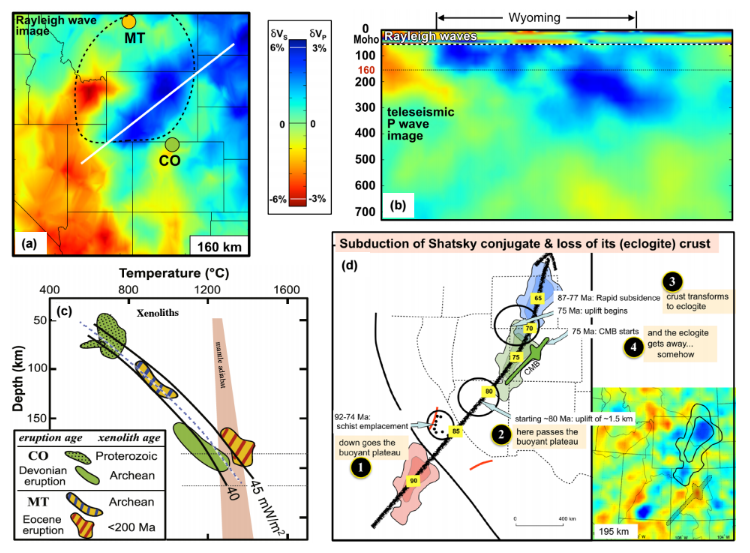Science Nugget - By Eugene Humphreys (University of Oregon Eugene) and Robert van der Hilst (MIT) - NSF # EAR 952194 | 2010-2012
Seismic tomography images high-velocity mantle beneath the Wyoming craton extending t~300 km depth. Although xenoliths and isostatic arguments suggest that this mantle is depleted of basaltic component, it is not typical craton: xenoliths suggest that the base of Archean mantle was truncated from ~200 to 150 km depth since the Devonian, and that the deeper mantle is younger than ~200 Ma; and its NE elongate shape extends SW of the Wyoming craton. The Sevier -Laramide orogeny is the only significant Phanerozoic tectonic event to have affected the region, and presumably caused the truncation. Apparently, the base of the Wyoming craton was removed and a large volume of young, depleted (and therefor compositionally buoyant) mantle was emplaced beneath the Wyoming craton during the Sevier-Laramide orogeny. This can account for Wyoming’s high elevation that occurs in spite of its large volume of high-velocity (cool) mantle. We suggest the Wyoming craton experienced a phase of growth at ~75 Ma through a three-stage process. First, flat-slab subduction removed ~50 km off the base of the Archean Wyoming craton. This was followed by emplacement of basalt-depleted ocean plateau mantle lithosphere of the Shatsky Rise conjugate, which arrived in the early Laramide. The geologic record of vertical motion in the Wyoming region suggests that the plateau’s crust first eclogized and then escaped into the Earth’s interior at 70-75 Ma. Initiation of Colorado Mineral Belt magmatism at 75Ma may represent a Farallon slab rupture through which the ocean crust escaped.

References
Humphreys, E.D. B. Schmandt, M.J.Bezada, J. Perry-Houts, 2015, Recent craton growth by slab stacking beneath Wyoming, Earth Planet, Sci. Lett, 429, 170-180.
Liu, L., Gurnis, M., Seton, M., Saleeby, J., Müller, R.D., Jackson, J., 2010. The role of oceanic plateau subduction in the Laramide orogeny. Nat. Geosci., I, 353–357.
Shen, W., M.H. Ritzwoller, V. Schulte-Pelkum, 2013. A 3-D model of the crust and uppermost mantle beneath the Central and Western US by joint inversion of receiver functions and surface wave dispersion., J. Geophys. Res., 118, 262–276.





